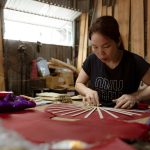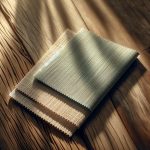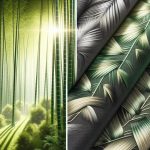When it comes to choosing performance fabrics, you might wonder which options are truly eco-friendly. There are several sustainable materials that not only enhance comfort but also minimize environmental impact. From the softness of organic cotton to the innovative properties of Tencel, each fabric has its own unique benefits. Let’s explore these options and see how they can fit into your sustainable wardrobe choices.
Table of Contents
Key Takeaways
- Organic cotton is soft, breathable, and grown without harmful chemicals, making it a sustainable choice for performance wear.
- Bamboo fabric offers natural moisture-wicking properties and antibacterial qualities, ensuring comfort and odor reduction during physical activities.
- Tencel, derived from sustainably sourced wood pulp, provides a smooth texture and moisture management for activewear while being biodegradable.
- Hemp is a resilient, fast-growing fiber that is breathable, moisture-wicking, and resists mildew, making it ideal for eco-friendly performance garments.
- Linen is durable and breathable, made from flax, requiring minimal resources, and is biodegradable, offering a low-impact alternative for warm-weather apparel.
Organic Cotton: A Soft and Sustainable Choice
When you choose organic cotton, you’re opting for a fabric that’s not only incredibly soft but also environmentally friendly. Grown without harmful pesticides and synthetic fertilizers, organic cotton supports sustainable farming practices.
You’re helping to reduce water consumption and promote healthier soil, contributing to a more sustainable planet.
Additionally, organic cotton is gentle on your skin, making it an excellent choice for sensitive individuals. Its breathability guarantees comfort in various climates, whether you’re lounging at home or on the go.
Organic cotton offers a soft, breathable experience, perfect for sensitive skin and comfortable in any climate.
Plus, you’ll find a wide array of stylish options, from casual wear to elegant pieces. By selecting organic cotton, you’re making a conscious choice that benefits both you and the environment, proving that comfort can go hand in hand with sustainability.
Bamboo: Nature’s Performance Fabric
Bamboo stands out as a remarkable performance fabric, combining sustainability with exceptional qualities. You’ll appreciate its natural breathability, which keeps you cool and comfortable during workouts.
Plus, bamboo’s moisture-wicking properties help manage sweat, ensuring you stay dry. This fabric is also incredibly soft, making it a pleasure to wear against your skin.
Another great benefit is bamboo’s natural antibacterial properties, which help reduce odors and keep your gear fresh for longer.
When you choose bamboo, you’re supporting a renewable resource that grows quickly without harmful pesticides. Its biodegradable nature means it won’t contribute to landfill waste.
Tencel: Innovative and Eco-Friendly
Tencel, a fiber derived from sustainably sourced wood pulp, offers an innovative solution for eco-conscious consumers seeking high-performance fabrics.
This biodegradable material is produced using a closed-loop process that recycles water and solvents, minimizing waste and environmental impact.
Tencel’s smooth texture and breathability make it perfect for activewear, while its moisture-wicking properties keep you comfortable during workouts.
You’ll also appreciate its natural antibacterial qualities, which help reduce odor.
Plus, Tencel is soft against your skin, making it suitable for everyday wear.
By choosing Tencel, you’re not just investing in quality and performance; you’re also supporting sustainable practices.
Hemp: The Sustainable Superfiber
Sustainability in fabrics continues to gain traction, and hemp stands out as a remarkable option. This versatile plant grows quickly, needs minimal water, and thrives without harmful pesticides.
When you choose hemp, you’re opting for a fiber that’s not only durable but also biodegradable. The cultivation process enriches the soil, promoting healthier ecosystems.
Hemp fibers are naturally breathable and moisture-wicking, making them ideal for performance wear. You’ll appreciate how hemp resists mildew, mold, and UV rays, ensuring your garments last longer.
Plus, it offers a unique texture that softens with each wash, enhancing comfort. By incorporating hemp into your wardrobe, you’re making a conscious choice towards sustainability while enjoying high-quality, functional fabrics.
Incorporating hemp into your wardrobe not only enhances comfort but also supports sustainable fashion choices.
It’s a win-win for you and the planet.
Linen: Breathable and Low-Impact
When you’re looking for a fabric that combines breathability with eco-consciousness, linen is an excellent choice. Made from the flax plant, it requires minimal water and pesticides, making it a low-impact option for the environment.
Its natural fibers allow for excellent airflow, keeping you cool and comfortable in warm weather. Plus, linen’s durability means it lasts longer than many synthetic fabrics, reducing waste.
You’ll appreciate how linen gets softer with each wash, enhancing its comfort while maintaining its structure. It’s also biodegradable, ensuring it won’t linger in landfills.
Frequently Asked Questions
How Do Eco-Friendly Fabrics Compare in Durability to Conventional Fabrics?
You might think eco-friendly fabrics fall apart like wet tissue paper, but they often rival conventional ones in durability. With proper care, they can withstand years of wear and tear while being kinder to our planet!
Can Eco-Friendly Fabrics Be Machine Washed and Dried?
Yes, eco-friendly fabrics can often be machine washed and dried, just like conventional ones. Always check the care label for specific instructions to guarantee you maintain their quality and longevity while being environmentally conscious.
Are There Any Allergens Associated With Eco-Friendly Fabrics?
You might encounter some allergens in eco-friendly fabrics, particularly if you’re sensitive to natural fibers like wool or cotton. However, many brands prioritize hypoallergenic materials, making them suitable for most individuals with allergy concerns.
What Is the Typical Lifespan of Eco-Friendly Performance Fabrics?
When you think of eco-friendly performance fabrics, imagine a sustainable journey. Typically, these fabrics last between three to five years, depending on usage and care, ensuring your commitment to the environment remains strong and enduring.
How Do I Care for Eco-Friendly Fabrics to Maintain Their Properties?
To care for eco-friendly fabrics, wash them in cold water, use mild detergents, and avoid fabric softeners. Air dry whenever possible, and store them away from direct sunlight to maintain their properties and longevity.
- A Guide to Buying Herringbone Fabric by the Yard Online - June 19, 2025
- Is Herringbone a Good Fabric for Shirts? A Detailed Analysis - June 19, 2025
- Finding the Perfect Brown Herringbone Wool Fabric for Your Project - June 19, 2025







